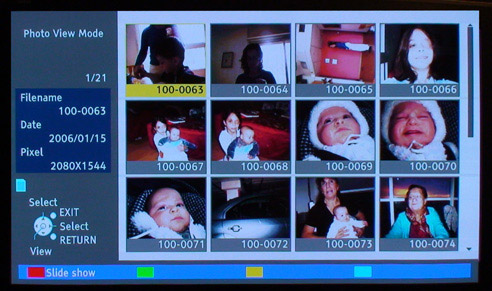Picture Quality
As always, I use a small number of movies and
sequences I am very familiar with, which demonstrate various capabilities
(or lack thereof) of the displays I test.
The first movie in this specific test is
Narnia. This movie, in glorious 1080p, really shows off how high contrast
works on plasmas and LCDs. Many movie scenes here have dark figures standing
in glaringly white snow. Mixed scenes like these tend to lose details both
in the high IRE (white detail) and low IRE ranges (black detail). Detail in
this Panasonic plasma was
excellent in both ranges, likely due to the lower gamma setting chosen by
Panasonic, but this was at the expense of a slightly less three-dimensional
image.
A particularly tough image was during the
escape scene of The Fifth Element (which I have been using for this test in
various formats ever since the first Superbit version came out quite a few
years ago). The policemens' uniforms are pure black, and in most displays
it's quite difficult to make out any patterns on them. With the PV700, I could
see some detail on the uniform even despite the bright lights on their
chests.
Detail level was also very high when Lilu was
crawling through the ventilation tunnels en route to her
unsuspecting taxi. This scene contains both bright lights shining on her
face against a dark stained ventilation tunnel. Both her face and in
particular, the badly red-colored/blond rooted hair were in full detail.
For the SDTV tests, I used satellite
programming and broke
out ye olde DVD. Satellite looked good, although 4:3 conversion should be improved by Panasonic, not because it's not great, but just
because something works well doesn't mean you shouldn't improve it. The unit
has MPEG NR (Noise Reduction) which works well (not as well as an external processor, mind
you), but it does have some good impact on an overly compressed image.
This capability is also quite useful for those
who like high sharpness. I've witnessed quite a few people become impressed
by artificial sharpness, although no real detail is added – only edge
enhancement (EE) halo artifacts. Increasing sharpness with a high NR ratio may
help alleviate some of the artifacts that sharpness alone produces.
Personally, I would prefer dialing down the sharpness to the point where it
produces as little EE as possible.
The SD
Card
The SD card slot opens with a slight touch to
the front panel. When the SD card is inserted, it gives off a nice bluish
light. This is a very stylish solution, and images pop up right away.
Navigation could not be simpler, and I easily found my way around. It's
simple to rotate the image and make a nice presentation.

My only wish is that the slot were a universal
one, so that I could insert a disk-on-key, or even a memory stick from my
Sony camera.
Aspect Ratios
As I mentioned earlier, one of the aspect ratio
adjustment modes, called "JUST", which is a Non-Linear-Stretch (NLS), tries to squeeze 4:3 content into a 16:9
screen by deforming the sides of the images and losing a bit of information
from above and below the image. It does work well, but if anyone from
Panasonic is listening – please add more adjustment features to this aspect
ratio menu item (or maybe an additional variation of it). This feature has
not been touched since at least 5 or so plasma generations back, and
although it still works fine, I find myself coveting additional options.
This mode only distracted me when watching news with stock-ticker headlines
at the bottom (does anyone still try to read those?)
In addition to this mode, the unit offers a
native 16:9 mode and two variations of Zoom (one anamorphic zoom and one 4:3 zoom).
All modes include about 4-5% overscan in all
video inputs, and I could not find a way to turn this off, although none of my
sources need overscan.
 Remote
Control
Remote
Control
The remote is a far cry from the professional
Panasonic remotes, meaning it feels solid, well built and well designed.
Sadly, Panasonic has not considered that people might actually be using a
smart remote and neglected to add discrete input access. Also, the remote
does not have a separate Power On/Standby button. I understand the approach, after
all grandma might not be able to figure out she needs to press two different
buttons to turn the TV on or turn it off.
Conclusions
The 700 series is a good, solid performer, and
Panasonic-lovers worldwide will buy them without regret. The new
non-reflective front panel is a bit distracting to me, and it does take some
getting used to. There are definitely enough inputs for almost any size
system I can think of.
Lack of Native Rate is a glaring omission and
Panasonic should definitely address the issue. Also, I would also love more
access to the calibration features that professional sets receive – if
Panasonic is worried about abuse, they might want to hide these under an
"Advanced" menu.
- Ofer LaOr -
Mr. LaOr is Editor of Hometheater.Co.Il, a Hi-Fi
magazine published in Israel. He is also the moderator for the AVS Forum
Video Processing section.